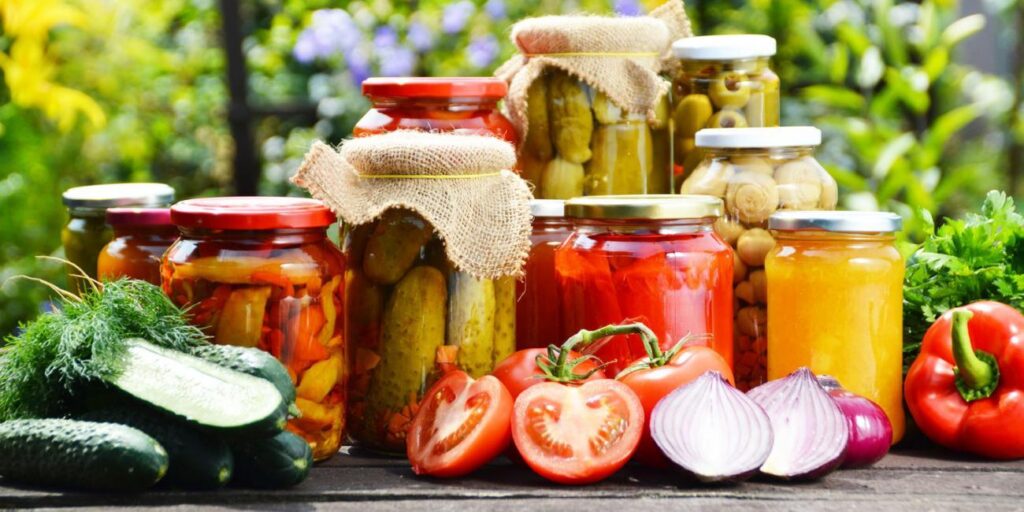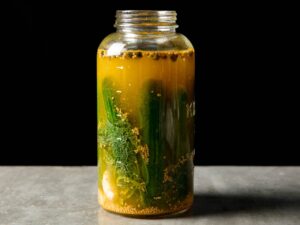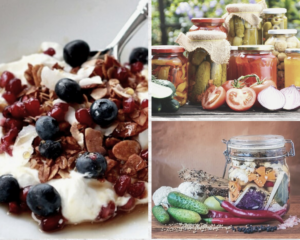
If you have a bubbly bottle of Champagne, a robust hunk of blue cheese, a creamy tub of Greek yogurt, or a bottle of delicious sparkling kombucha in your kitchen—guess what? You’re on the cutting edge of an emerging food trend, fermentation, and we couldn’t be happier for you.
Why?
Because processed foods have flooded the Western diet—and we’re all paying for it with our health.
After the Industrial Revolution, processed foods’ convenience and affordability skyrocketed them to a place of prominence on dinner plates. And with the invention of refrigeration and food additives, we drifted away from mainstay traditional food preservation practices like fermentation—but that’s all changing, and fast!
Recent data has shown that the consumption of fermented foods in the U.S. was up a stunning 149% in 2018 alone.
The problem with a Western diet is that it’s laden with cheap and processed fast foods. This is contributing to a health crisis with skyrocketing rates of obesity, heart disease, and diabetes.
And that’s precisely why you should be ditching quick fixes in your diet and swapping in highly beneficial lacto-fermented foods if you want to enjoy the quality of health our great grandparents once had.
Our ancestors knew this one universal truth—good things take time.
What is Lacto-Fermentation?
Do you love the bright and tangy flavor of kimchi, sauerkraut, or pickles? If so, you’re enjoying the hallmark flavor of lacto-fermentation.
What was once a simple food preservation mechanism has exploded into a full-blown health food craze.
Lacto-fermentation is probably how your great grandparents preserved their summer harvest and requires nothing more than vegetables, salt, water, and a little patience.
With more of us staying closer to home these days, fermentation is reemerging as a hobby that boosts immunity and connects us with our shared past. There are over 1 million posts tagged #fermentation on Instagram as we write this.
The History of Fermentation
Fermentation is as old as humanity. It’s been reported that ancient Chinese dynasties used fermentation for rice wine as early as 4000 BC. But historians believe we were fermenting things for MUCH longer than that.
Since records of many ancient civilizations are lost to history, we don’t know exactly when humans started purposefully fermenting food and drink.
Still, it’s important to remember fermentation happens without human intervention as well. Yeast, just one microbe responsible for fermentation, has been around for at least 80 million years.
How does Lacto-Fermentation Work?

This straight-forward process happens in two stages:
Stage 1— In stage one, your choice of vegetables is submerged in a brine solution (salt and water). You want your brine to incorporate enough salt to kill off harmful bacteria but allow lactobacillus (good bacteria) to flourish.
Note: lactobacillus is the same strain of good bacteria used in most probiotic supplements.
Stage 2—In stage two, the fermentation begins. This happens when the lactobacillus bacteria start to convert the lactose and other naturally present sugars in your vegetables into lactic acid.
Once fermentation begins, the environment becomes acidic—safely and effectively preserving your food.
That’s it.
Sanitization is Key
The main thing to remember when it comes to fermentation of ANY kind is sanitation. It may sound counterproductive to meticulously clean your kitchen before letting bacteria do its thing with a batch of vegetables—but don’t miss this step.
You need to be sure your environment, hands, clothes, vessels, and kitchen tools are all sanitized to avoid introducing unfavorable bacteria that could throw your entire fermentation project out of whack.
Remember—fermentation is all about keeping the good bacteria in and the harmful bacteria out.
Top 5 Health Benefits of Lacto-Fermented Foods

The complex umami flavors of fermented foods have been known to arouse the palates of foodies around the globe, but don’t forget these health-boosting benefits, especially if you suffer from chronic pain, inflammation, or autoimmune issues:
- Digestive Health— The good-for-you bacteria in fermented foods positively affect your digestive tract. Studies have found fermented foods to be beneficial in treating and preventing gastrointestinal diseases, minimizing the uncomfortable effects of irritable bowel syndrome, and ensuring regularity. If you frequently have gut troubles, be sure to stock up on your favorite ferments and enjoy them frequently.
- Immune System Support— The connection between gut health and immunity is undeniable—it’s all due to the high amounts of probiotics found in fermented foods. Many of your favorite fermented foods are also high in vitamin C, zinc, and iron—all good allies in the fight against cold and flu season.
- Anti-Inflammatory Benefits— By ensuring your gut health is top-notch, you will be helping to reduce inflammation in your body. Research on sauerkraut has shown it to have antioxidant, anti-inflammatory, and chemopreventive action against certain types of cancer due to its specific phytochemicals.
- May Help Prevent Some Cancers— A 2014 study showed that probiotic-rich fermented foods could work as a potential preventative measure to avoiding colorectal cancer—the second leading cause of cancer-related death in the U.S.
- Reduces Stress and Anxiety— We’ve previously discussed the Gut-Brain Axis, but did you know that fermented foods can help you address the stress of anxiety? A 2015 study identified a link between probiotics found in fermented foods and reduced social anxiety symptoms in young adults.
New and exciting research on the health benefits of fermented foods is emerging every day. As this health food’s popularity takes off, we expect there to be exciting findings for years to come.
Your Fermented Foods Grocery List
Ready to start feeling the benefits of fermented foods? You can certainly ferment your own and save money; we’ve included a recipe at the end of this blog to get you kick-started.
But if you’re short on time, look for these easy to come by fermented foods in your supermarket next time you take a shopping trip:
- Sauerkraut
- Kimchi
- Pickles
- Raw Cheeses
- Yogurt
- Kefir
- Kombucha
- Tempeh
- Miso
- Apple Cider Vinegar
- Sourdough Bread
*Note: Not all these foods are specifically lacto-fermented but eating fermented food of any kind is hugely beneficial to your health.
For Better Health, Eat Like Your Great Grandparents
Here we are today, faced with difficult diet decisions at every turn—what do you do? Eat like your great grandparents.
It’s almost assured they enjoyed the complex flavors and numerous health benefits of fermented foods regularly—especially during the dark and cold months of winter.
Please reach out if you would like to learn more about the essential role nutrition plays in your health and healing. Our private membership program and online training community provides you with the guidance and support you need to achieve a happy, healthy, and pain-free life once and for all.
Recipe—Lacto-fermented Carrots:

Enjoy these fermented carrots in recipes, in place of fresh carrots, or as a snack.
Ingredients:
- Fresh, Organic Carrots
- Sea Salt or Kosher Salt
- 1 T Grated Fresh Ginger per Jar (Optional – you can also substitute with your seasoning of choice)
Directions:
Fill a clean quart jar (narrow mouth works best) with carrots, cut in rounds or sticks.
Pack them in as tightly as possible to prevent large air pockets.
In a cup or another jar, add 4 cups of warm (not hot!) water and 2 Tbsp salt. Let the salt dissolve, then pour over the carrots until covered.
If you have a canning weight, place it on top to prevent carrots from floating to the surface.
If you don’t, you can stuff a cabbage or kale leaf into the opening, making sure it’s keeping the carrots under the level of the water.
Let this sit in a dark place such as a pantry for 2-3 weeks, loosening the lid every few days to prevent pressure from building up.
Once they’re fermented enough for your taste, refrigerate to halt the fermentation process.
This fermentation process is highly versatile. Try it with cabbage, cucumber, green beans, radishes, garlic, or any other vegetable you enjoy.





